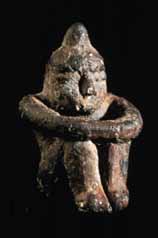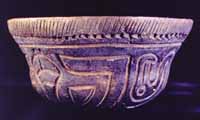
 |
Seated pottery figurine, Smiling Dan site, Scott County. | |
|
This tiny-its less than one inch tall-2,000-year-old clay figurine is one example of many human figurines made by Native American artisans during the Middle Woodland period. Figurines are often the only clues to the appearance of ancient Native Americans. |
||
Who made the first bow and arrow? What is important about obsidian (volcanic glass), marine shell, mica, and copper? Where was corn first grown? How was pottery invented? Why did Native Americans build burial mounds? We must explore these questions to understand the Woodland period. The invention of pottery, plant cultivation, mound building, and trade appear first during the Archaic Period in Illinois, but they become much more important and more advanced during the Woodland period. In contrast, the bow and arrow were invented during the Woodland period. These tools and practices represent part of a very different way of life.
The Woodland period is divided into Early (3,000 to 2,200 years ago), Middle (2,200 to 1,800 years ago) and Late (1,800 to 1,250 years ago) sub-periods. Like the Archaic Period, each Woodland sub-period represents a slightly different way of life. Pottery first appears in Illinois during the Early Woodland. Before this time containers were made of wood, plant fiber, or leather. Long-distance trade and new forms of artistic expression flourish during the Middle Woodland. The bow and arrow and the cultivation of corn distinguish the Late Woodland. In contrast to the Archaic Period, the rate of change is much greater during the Woodland period.
 |
Pottery bowl, Elizabeth site, Pike County. | |
|
Prehistoric pottery was made by mixing together clay, temper (stone, sand, shell or crushed pottery added to strengthen the pot and ensure even drying), and water. Just the right amount of water made the mixture plastic, but strong enough to be shaped into containers. After shaping and smoothing the container, Native Americans often applied symbols to its exterior, such as the abstract bird symbol seen on this two-thousand-year-old bowl. In Illinois, people of the Woodland period were the first to make extensive use of pottery. |
||
Unlike the Archaic Period, environment appears to have little to do with changes in the Woodland way of life. Instead, Woodland life develops as Native Americans learn to live with a greater number of neighbors.
|
|
Copyright © 2000 Illinois State Museum